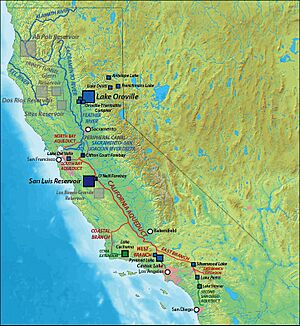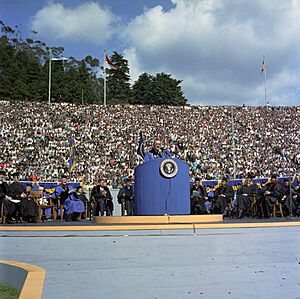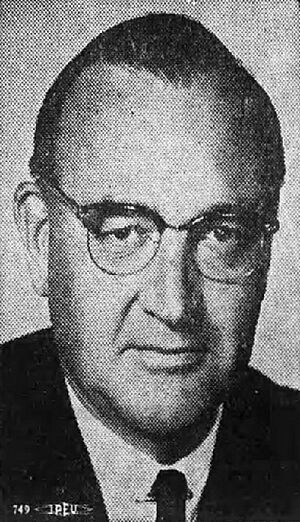Pat Brown facts for kids
Quick facts for kids
Pat Brown
|
|
|---|---|
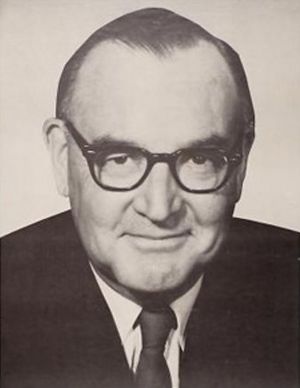
Brown in 1962
|
|
| 32nd Governor of California | |
| In office January 5, 1959 – January 2, 1967 |
|
| Lieutenant | Glenn M. Anderson |
| Preceded by | Goodwin Knight |
| Succeeded by | Ronald Reagan |
| 23rd Attorney General of California | |
| In office January 8, 1951 – January 5, 1959 |
|
| Governor | Earl Warren Goodwin Knight |
| Preceded by | Frederick N. Howser |
| Succeeded by | Stanley Mosk |
| 21st District Attorney of San Francisco | |
| In office 1943–1950 |
|
| Preceded by | Matthew Brady |
| Succeeded by | Thomas C. Lynch |
| Personal details | |
| Born |
Edmund Gerald Brown
April 21, 1905 San Francisco, California, U.S. |
| Died | February 16, 1996 (aged 90) Beverly Hills, California |
| Resting place | Holy Cross Cemetery (Colma, California) |
| Political party | Democratic (1932–1996) |
| Other political affiliations |
Republican (before 1932) |
| Spouse |
Bernice Layne
(m. 1930) |
| Children | 4, including Jerry and Kathleen |
| Alma mater | San Francisco Law School (LLB) |
| Profession | Lawyer |
Edmund Gerald "Pat" Brown (born April 21, 1905 – died February 16, 1996) was an American lawyer and politician. He served as the 32nd governor of California from 1959 to 1967. Before becoming governor, he was the district attorney for San Francisco. He was also elected Attorney General of California in 1950.
Brown was born in San Francisco. He was interested in speaking and politics from a young age. He studied law at night and earned his law degree in 1927. As governor, Brown helped pass important laws. These included a tax increase and the California Master Plan for Higher Education. He also started the huge California State Water Project. This project moved water across the state. He also supported civil rights laws.
In his second term, Brown faced some challenges. These included protests and riots. He lost his bid for a third term to Ronald Reagan in 1966. Today, many people see him as the person who helped build modern California. His son, Jerry Brown, also became Governor of California. His daughter, Kathleen Brown, was the State Treasurer.
Contents
Early Life and Education
Brown was born in San Francisco, California. He was one of four children. His father's family was Irish Catholic. His mother's family was German Protestant. He got the nickname "Pat" in school. This was because he was a good speaker, like Patrick Henry. When he was 12, he sold Liberty Bonds. He would often end his speeches with "Give me liberty, or give me death."
Brown was a debate champion in high school. He attended Lowell High School. He graduated in 1923. Instead of going to college, he worked at his father's cigar store. He studied law at night. In 1927, he earned his law degree from San Francisco Law School. After passing the bar exam, he started working as a lawyer.
Start in Politics
Brown first ran for the State Assembly in 1928. He ran as a Republican Party candidate but lost. In 1934, he joined the Democratic Party. This was during the Great Depression. He felt the Republican Party was too focused on business. He became a strong supporter of the New Deal. In 1939, he ran for District Attorney of San Francisco. He lost to the person who already held the job.
District Attorney and Attorney General
Four years later, Brown ran for district attorney again in 1943. His slogan was "Crack down on crime, elect Brown this time." He won this time, which surprised many people. He was reelected in 1947. He worked hard against gambling, corruption, and youth crime. This work brought attention to his office.
In 1946, Brown ran for Attorney General of California. He lost that race. But in 1950, he won the election for Attorney General. He was re-elected in 1954. As Attorney General, he was the only Democrat to win a statewide election in California.
First Term as Governor (1959–1963)
In 1958, Brown ran for governor. He promised "responsible liberalism." This meant he supported workers. He won the election by a large margin. He defeated Republican U.S. Senator William F. Knowland. Democrats also won most other statewide offices.
Brown was known for his happy personality. He wanted to build up California's services. The state was growing very fast. He helped build new highways and universities. He also started a huge water system. This system helped bring water to farms and cities. Brown appointed a strong team to help him. He also worked with Democratic leaders in the state legislature. He helped create a Fair Employment Practices Commission. This commission helped African Americans get better jobs.
Raising State Funds
Brown wanted to expand state services. First, he needed to fix the state's budget problems. He also needed money for his big plans. He raised taxes, including the personal income tax. He also increased taxes on banks and corporations. There were new taxes on cigarettes, beer, and betting. He also added a tax on oil and natural gas. These changes gave him the money he needed. But he also got a reputation as a governor who raised taxes.
California State Water Project
When Brown became governor in 1959, he started big projects. Millions of new people were moving to California. The state also had times of drought. This put a lot of stress on California's water. Especially in dry Southern California. This led to the California State Water Project. The goal was to bring water to areas that needed it. Half of the state's people lived where there was only one percent of the state's water.
The project included many reservoirs, aqueducts, and pipelines. These would move water across the state. It would capture water from the Sacramento River. Then it would send it through the San Joaquin Valley. This would water dry farm areas. It would also provide water to Southern California, especially Los Angeles County. This water was needed for more people and businesses. The project was planned to take 60 years. It was estimated to cost $13 billion.
Many people were against the project. People near the Sacramento River Delta worried about saltwater getting into their water. People in Northern California worried the South would take too much water. Governor Brown strongly supported the plan. He worked hard to solve problems and convince critics. He asked Congress to make special rules for California. He said the project would create jobs and help everyone. He also lowered the initial bond amount. He started a TV campaign to get public support. The plan was approved in 1960. Southern California's growing population helped it pass.
Government Changes
In Brown's first year, he ended the "cross-filing" system. This system allowed candidates to run for office under more than one political party. In 1964, the Supreme Court changed how state senators were chosen. Before, it was based on county lines. Now, it had to be based on population. This meant Los Angeles County got many more senators than San Francisco. This led to big changes in the legislature.
Brown also helped create the Constitutional Revision Commission in 1962. This group worked to make California's constitution shorter and simpler. They suggested many changes. Most of these changes were approved by voters. For example, they removed limits on how long legislative sessions could be. They also increased lawmakers' salaries.
Improving Education
People in California wanted to improve education. They wanted to catch up with the Soviet Union. The Soviets had launched the first space satellite, Sputnik 1. In 1960, Brown signed the California Master Plan for Higher Education. This plan set up clear roles for the University of California, the California State University, and California Community College systems. Each system had different goals and types of students. This plan became a model for other states. Governor Brown wanted higher education to be free for California students. The Master Plan made this possible. His successor, Ronald Reagan, later changed this policy and added tuition fees.
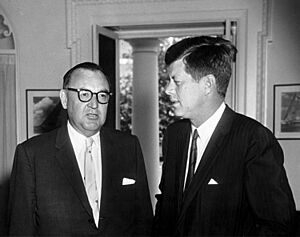
Re-election Against Richard Nixon (1962)
Brown's first term as governor was very successful. But he faced challenges on some issues important to him. For example, his efforts to pass a $1.25 per hour minimum wage failed. Also, he was against the death penalty, but most people in the state supported it.
Brown supported Senator John F. Kennedy in the 1960 Presidential election. Brown's opponent in the 1962 governor's race was Richard Nixon. Nixon had just lost the presidency to John F. Kennedy in 1960. Nixon was not very familiar with California politics. He tried to accuse Brown of being "soft" on communism. This was not a popular idea. In the November 1962 election, Brown was reelected governor. He won by a four-point margin. After his loss, Nixon famously held his self-proclaimed "last press conference".
Second Term as Governor (1963–1967)
During his second term, the legislature passed the Rumford Fair Housing Act. This law said that landlords could not refuse housing to people based on their race, religion, or other factors. This new law led to many lawsuits. It also led to California Proposition 14 (1964). This proposition tried to overturn the Rumford Act. Nearly two-thirds of voters supported it. However, the U.S. Supreme Court later said that Proposition 14 was unconstitutional.
Brown's time in office saw a big increase in water projects. The California Aqueduct was built as part of this. It was later named after him. He also oversaw the Master Plan for Higher Education. He supported fair employment laws. He also created a state economic development commission. He helped pass about 35 major new laws.
Watts Riots
On August 11, 1965, the Watts riots started in the Watts neighborhood of Los Angeles. They lasted for a week. The riots began after a traffic stop. A fight started, and soon large crowds gathered. By August 13, Governor Brown sent the National Guard to Watts. By the end of the riots, 34 people had died. About 1,000 people were hurt. There was $40 million worth of damage. About 1,000 buildings were destroyed. This event, along with the Vietnam War, started to make Brown less popular.
Death Penalty Views
During his time as governor, Brown changed 23 death sentences to life in prison. He signed his first commutation on his second day in office. One notable case was Erwin "Machine-Gun" Walker. Brown changed Walker's death sentence to life without parole. However, the California Supreme Court later said Brown could not legally stop a prisoner from being paroled in such cases. Another prisoner whose death sentence Brown changed later committed another murder after being paroled.
Brown's feelings about the death penalty were mixed. He later said he denied clemency in one case because a lawmaker needed his vote for a farmworker law. The lawmaker told him his district would be very angry if he changed the sentence.
However, Governor Brown also approved 36 executions. These included the cases of Caryl Chessman in 1960 and Elizabeth Duncan. She was the last woman put to death before a national pause on executions. Brown had supported the death penalty earlier in his career. But he later became against it. He tried to abolish the death penalty, but his proposal failed. His successor, Ronald Reagan, strongly supported the death penalty.
Campaign for a Third Term
Brown decided to run for a third term as governor. This went against an earlier promise he made. This hurt his popularity. He faced a tough fight in the Democratic primary election. This was unusual for a sitting governor. Los Angeles Mayor Sam Yorty got almost 40 percent of the primary vote. Brown only got 52 percent.
The California Republican Party saw Brown's falling popularity. They nominated a well-known actor and union leader, Ronald Reagan. Reagan ran a "law-and-order" campaign. He won the Republican primary easily. Brown first ran a quiet campaign. He said running the state was his main focus. But as Reagan's lead grew, Brown started to panic. He made a big mistake in a TV ad. He reminded school children that an actor (meaning John Wilkes Booth) had killed Abraham Lincoln. This was a bad comparison to Reagan, who was an actor. It made Brown's campaign even weaker.
On election day, Reagan was expected to win. Brown lost the 1966 election to Ronald Reagan. Reagan won by a huge margin. His victory was a big surprise. Reagan won almost 1 million more votes than Brown.
Brown's Legacy
Even though he lost his last election, Brown's time in office is seen as very successful. He was a popular Democrat in a state that often voted Republican. After he beat Richard Nixon in 1962, he was considered as a running mate for Lyndon Johnson in the 1964 presidential election. However, his popularity dropped during the Watts riots and early anti–Vietnam War protests at U.C. Berkeley.
His huge building projects, like aqueducts and canals, created new farmland. The Governor Edmund G. Brown California Aqueduct was named after him. During his time, four new University of California campuses were built. Also, seven new California State University campuses were added. This made California's higher education system the largest in the world.
Brown was the last governor to lose a general election while in office. This was until Gray Davis lost in the 2003 recall election. Today, Governor Brown is widely seen as the person who created modern California.
Family Life
Brown's wife, Bernice Layne, went to the same high school as him. They started dating after he finished law school and she finished her teaching degree. They got married in 1929. They had four children, all born in San Francisco:
- Barbara Layne Brown (born 1931)
- Cynthia Arden Brown (born 1933 – died 2015)
- Edmund Gerald "Jerry" Brown Jr. (born 1938)
- Kathleen Lynn Brown (born 1945)
In 1958, as governor-elect, Brown appeared on the TV show What's My Line? Brown died at age 90 in Beverly Hills. He is buried at Holy Cross Cemetery in Colma.
Presidential Politics
Unlike his son Jerry Brown, Pat Brown never seriously ran for President of the United States. But he was often California's "favorite son." This means he was a popular choice from his home state. In the 1952 Democratic primaries, Brown finished second in total votes. He lost California to Estes Kefauver.
During Brown's first term as governor, California became the most populated state. This, along with his popularity, helped two national presidential candidates. He pledged California's votes to John F. Kennedy in 1960 and Lyndon B. Johnson in 1964. As governor, Brown was again California's favorite son in 1960. He won his home state by a large margin. He finished second nationally behind John F. Kennedy, who became the nominee.
In the 1964 primaries, Brown ran only in California. He finished first in California and nationally. However, he was supporting Lyndon B. Johnson, who was already the sitting president. Johnson's nomination was certain. Brown also briefly sought the vice presidential nomination in 1956.
Election Results
| Party | Candidate | Votes | % | |||
|---|---|---|---|---|---|---|
| Democratic | Pat Brown | 3,140,076 | 59.75 | |||
| Republican | William F. Knowland | 2,110,911 | 40.16 | |||
| No party | William P. Gale (write-in) | 4,790 | 0.09 | |||
| Total votes | 5,255,777 | 100.00 | ||||
| Turnout | ||||||
| Democratic gain from Republican | ||||||
| Party | Candidate | Votes | % | |
|---|---|---|---|---|
| Democratic | Pat Brown (I) | 3,037,109 | 51.92 | |
| Republican | Richard Nixon | 2,740,351 | 46.85 | |
| Prohibition | Robert L. Wyckoff | 69,700 | 1.12 | |
| Invalid or blank votes | 82,442 | 1.39 | ||
| Total votes | 5,929,602 | 100.00 | ||
| Turnout | 57.50 | |||
| Democratic hold | ||||
| Party | Candidate | Votes | % | |||
|---|---|---|---|---|---|---|
| Republican | Ronald Reagan | 3,742,913 | 57.55 | |||
| Democratic | Pat Brown (I) | 2,749,174 | 42.27 | |||
| Other | Various candidates | 11,358 | 0.18 | |||
| Total votes | 6,503,445 | 100.00 | ||||
| Turnout | 57.70 | |||||
| Republican gain from Democratic | ||||||
See also
 In Spanish: Pat Brown para niños
In Spanish: Pat Brown para niños
- Membership discrimination in California social clubs


